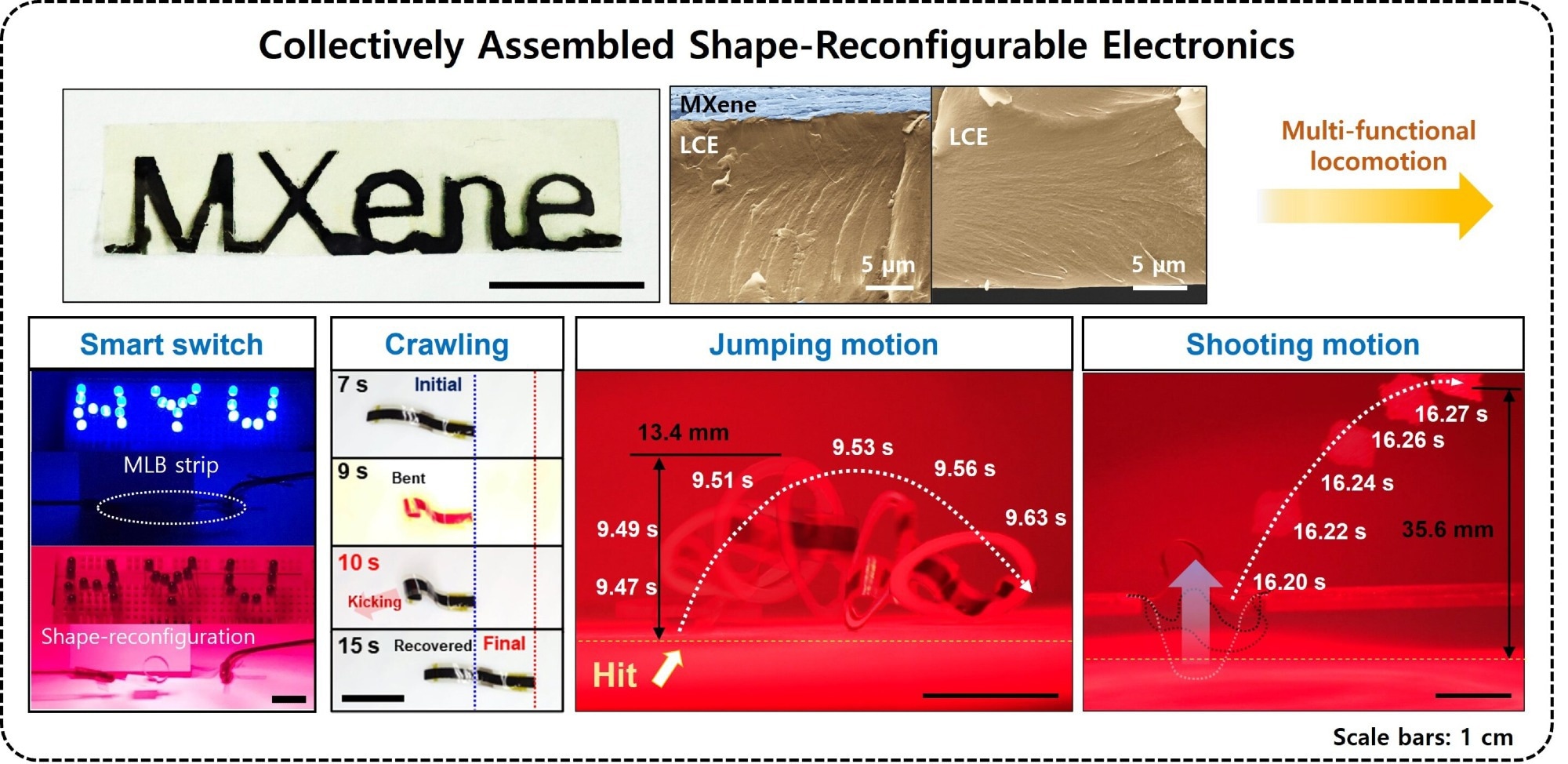The next generation of electronic devices, shape-reconfigurable electronics, show great promise beyond flexible electronics, which can be deformed into 3D curvilinear shapes by passive mechanical strain.
 Shape-reconfigurable and locomotive electronics based on collectively assembled liquid crystal elastomer/MXene bilayer (MLB). Image Credit: W. Cho, et al., Nano Energy, 118, 108953 (2023).
Shape-reconfigurable and locomotive electronics based on collectively assembled liquid crystal elastomer/MXene bilayer (MLB). Image Credit: W. Cho, et al., Nano Energy, 118, 108953 (2023).
Spatial constraints prevent passive mechanical deformation as electronics get smaller; therefore, physical contact and large, heavy power sources like batteries are required. The materials employed in shape-reconfigurable electronics actively respond to environmental stimuli, including temperature, light, and electricity, and carry out preprogrammed actuation to overcome the inherent limits of small devices.
These materials, known as stimuli-responsive materials, include ‘physical intelligence’ stored inside them. Since they can actively morph their shape into multiple 3D forms and modify their body position through reversible actuation, these physically intelligent materials act as a framework for shape-reconfigurable electronics.
Researchers led by Jeong Jae Wie, an Associate Professor in Hanyang University’s Department of Organic and Nano Engineering, have developed a novel concept of physical intelligence-encoded liquid crystal elastomer-based shape-reconfigurable electronics, demonstrating on-demand locomotion such as crawling, jumping, and sling-shooting small objects.
The material recognized for its use in liquid-crystal displays (LCDs), liquid crystal elastomer (LCE), is one of these promising physical intelligent materials. Combining anisotropic liquid crystalline (LCE) with other conductive fillers expands the potential of LCE as a platform for shape-reconfigurable electronics since its programmable alignment allows direction-controlled shape reconfiguration beyond its usage as a display material.
The research team successfully combined LCE with a highly conductive Ti3C2Tx MXene to build a bilayer structure in this study, which was reported in Nano Energy. MXene is a member of a relatively recent class of two-dimensional (2D) materials distinguished by excellent photo-thermal conversion efficiency and exceptional electrical conductivity.
MXene was successfully transferred to the LCE layer without physical delamination or damage using a specialized in-situ photopolymerization technique.
With a thickness of 370 nm, the MXene layer is 133 times thinner than the LCE layer, giving the bilayer minimal bending stiffness and allowing for good actuation performance.
Additionally, the recently produced LCE/MXene bilayer, known as MLB, has an electrical conductivity that is exceptionally high—roughly 5,300 S cm–1—and can power LEDs. The MLB exhibits photo- and electrothermally-driven actuation capabilities with voltage applications of less than 3.5 V and near-infrared light irradiation.
Taking into consideration the symmetry of assembly, collectively assembled structures were presented to achieve various shape-reconfiguration and movement with MLB.
MLBs that were symmetrically built showed inverse-chiral structure, S-, W-, and flower-like shapes. Moreover, asymmetrically formed MLBs with modifications to the length and molecular alignment of the component MLB units demonstrated directional crawling and rotation.
The asymmetrically constructed MLBs were capable of directed locomotion because of their constantly shifting center of mass during actuation. Motivated by snap-through instability, these assembled MLBs were also able to perform small object sling-shooting and hopping.
To achieve this, the research team developed a rigid paper frame and an alternately built structure that intentionally restricted the assembled MLBs’ ability to reconfigure their shapes and subsequently efficiently stored the elastic energy that resulted.
The completed MLB then used this elastic energy to create mechanical energy through snap-through, which allowed for quick and forceful jumping and sling-shooting motions.
Multi-functionality is a key component for next-generation electronics, and geometrical diversity enables shape-reconfigurable electronics to perform multi-modal actuation and locomotion.
Woongbi Cho, Study First Author and Graduate Research Assistant, Hanyang University
Professor Wie added, “Shape-reconfigurable electronics based on liquid crystal elastomer and MXene successfully extend the application of liquid crystalline polymers. We believe this technique can give insight into form shape-reconfigurable platforms which can be applied in various fields including energy storage devices, antennas, and miniaturized robotic systems.”
Journal Reference:
Cho, W., et al. (2023) Multi-functional locomotion of collectively assembled shape-reconfigurable electronics. Nano Energy. doi:10.1016/j.nanoen.2023.108953